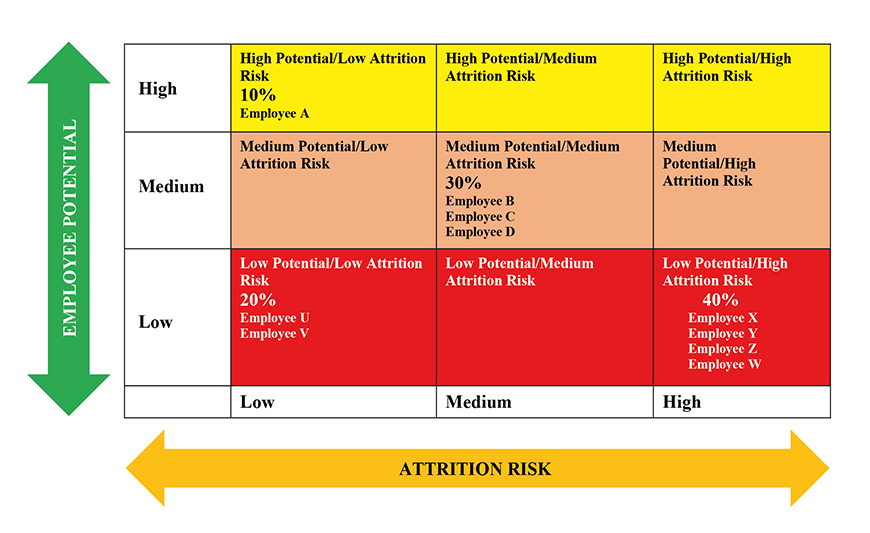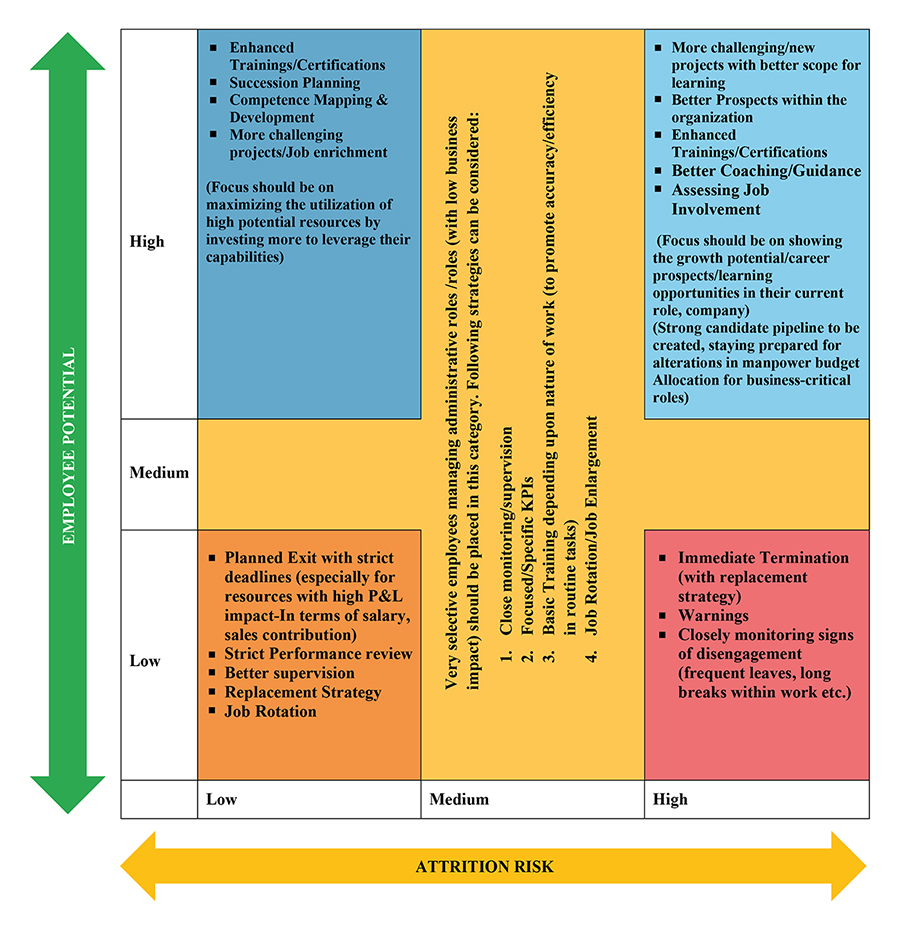Features
HR Matrices: A Tool for Logical Manpower Management
Written by: Shruti Verma, HR Manager at OMA Emirates
We have a tough role to play as human resources (HR) leaders. Dealing with human resources is all about dealing with a lot of perceptions, personalities, and attitudes. At times, it is just tough to put things in perspective and design a strategy that focuses on balancing the facts, emotions, and perceptions.
Interesting HR matrices can be created to evaluate the existing employees and to arrive at the best manpower management strategies. A logical HR matrix is created based on well-evaluated needs or concerns of the organization and which can prove to be a highly valuable tool for any organization.
Here is a brief 5-step guide on designing and using the HR matrices for the benefit of the current age dynamic organizations:
Step 1: Designing HR Matrix
What are the key concerns of company “X” with its human resources?
- Employee potential
- Employee performance
- Attrition risk
- Employee disengagement
- Lack of empowerment
Other interesting matrices could be:
- HR capability vs. business priority
- Management maturity vs. CHRO maturity
- Employee performance vs. employee potential
- Role of HR process orientation vs people orientation
They could range from a simple 4-box matrix to an elaborate 9-box matrix or so on based on how comprehensive one wants to be.
Step 2: Mapping Existing Employees to Manpower Matrix
This is one of the most critical steps and it must ensure:
- Very conscious manpower mapping is to be done while minimizing the perceptual bias
- Seeking 360-degree feedback on each employee to be mapped in the matrix: This will include an assessment of factual parameters, seeking detailed and focused feedback from colleagues, line managers, and other stakeholders
E.g., Conducting a 360-degree appraisal of a business development manager through various stakeholders might include the following:
Finance: Sales numbers, collection overdue, gross margins, overall accountability for account management, etc.
Clients: Quality of interaction, pro-active updates, availability for feedback or follow-ups, etc.
HR: Overall hygiene, sales performance, personality, attitude, compliance, growth potential, etc.
Line Manager: Quality of reports, adherence to timelines, quality of work, sales numbers, quality of account management, prospecting, etc.
- Sharing evaluation parameters in detail with the line managers to seek more inputs or seek detailed inputs on employee performance on various KPIs and making required changes
E.g., A Project Manager, who is rated highly positive in 360-degree evaluation, might be a constant defaulter on process compliance, over lenient with the team, and hence being ineffective in managing the team
- Making final adjustments based upon more concrete information from line managers
Step 3: Designing HR Strategy Based on Manpower Matrix
This will largely depend upon several other factors apart from an individual employee’s placement in the manpower matrix. HR strategy might focus on the following variable factors too:
- Preparation for contingencies or structural changes: candidate pipeline, manpower budget (to accommodate high replacement cost)
- Future Plans of the company: existing employees’ skillset might be needed for future projects. In such a situation, even a “low potential” employee has to be maintained unless a ready replacement is there
- Impact of the employee on P&L (salary, sales contribution, margin contribution).
E.g., It might be difficult to maintain a high salaried low potential resource vs. a low salaried low potential resource.
- The financial strength of the company (in terms of ability to maintain salaries of staff, withstanding low business performance)
- Critical nature of the role (e.g., Project Manager role may be seen as much more critical than any administrative role like Operations Executive). Business critical roles must be attended to on priority
- Feasibility of replacing low potential or low performing resources with strong personal relationships in the company due to the long service tenure
Since the business environment and employees are highly dynamic, the number of factors impacting the HR strategy could be uncountable. However, keeping all the other variable factors constant, the following manpower management strategies might be considered for various categories of employees:
Step 4: Presenting HR Strategy to the Management
This would largely involve the following HR Analytics:
- Number of business-critical roles held by low potential resources
- Number of business-critical roles held by employees with high attrition risk
- Percentage of employees identified as high potential, medium potential, and low potential
- Sales performance of employees placed as high potential, medium potential, and low potential. (Target vs achievement, gross margin contribution, new client’s addition, etc.)
- Percentage of salary spend on maintaining high, med, or low potential resources
- Work tenure of medium or low potential resources with the company
Strategy proposals could be:
- Manpower budget alterations required to hire new resources to replace low potential resources or high attrition risk resources
- Future investment in training, certifications, reward and recognition programs, employee engagement activities, etc. To maintain high potential resources
- Sources/timelines/talent acquisition investment for identifying replacements for business-critical resources
- Budget for increments for promoting high potential resources
E.g., An organization with more than 60 percent of employees identified as low potential might focus on investing in or arranging for replacements.
An organization with the majority of employees identified as having high potential, the focus might be on developing capabilities by increasing investment in T&D, learning programs, certifications, etc.
Step 5: Implementing the Strategy
Important considerations in implementation could be:
- Does the company need to maintain the low potential for any reason for some time or immediate termination can be considered?
- Does the company have ready replacements or a potential pipeline of candidates?
- Timelines for onboarding replacements and managing handover
- How potential opportunities can be created for upgrading high potential resources within the organization?
- Identifying tailor-made development program for every identified high potential resource and related investment
- Budget allocation for identified development programs and their impact on the overall HR budget.
- Identifying the role-specific competencies and implementing competency mapping for developing high potential resources further
- Overall business strategy is to expand, contract, diversify, etc.
About the Author:
Shruti Verma is an HR professional, who is currently serving OMA Emirates, UAE as Human Resources Manager. She has more than 10 years of professional experience gained from various industries and organizations in India and the UAE.
She is a Master’s Degree holder in HR and UGC NET-qualified lecturer. Apart from her mainstream career in human resources, she has actively pursued her passion for teaching and writing.
Connect with her at https://www.linkedin.com/in/shrutiverma1
Features
Redefining Real Estate: The Rise of Wellness-Centric Spaces

By Mark Phoenix – CEO of Sankari
The way we think about real estate is evolving, and at the heart of this change is a renewed focus on wellness. As we become more aware of the profound impact our living environments have on our health and well-being, it’s clear that real estate must go beyond aesthetics and luxury—it must support a lifestyle of vitality and longevity. To me, true luxury is no longer defined solely by opulence but by spaces that promote health, balance, and connection.
The demand for wellness-oriented spaces is growing rapidly, and real estate developers must rise to meet it. Today’s buyers are looking for more than just high-end finishes and exclusive locations—they want environments that enhance their well-being. Integrating wellness features such as fitness centers, yoga studios, meditation areas, and holistic health services is no longer an option; it’s a necessity. These spaces don’t just add value to a property; they create communities that create physical health, mental clarity, and social engagement.
Wellness-centric design is about more than just adding amenities—it’s about creating environments that encourage movement, relaxation, and human connection. By prioritizing well-being in real estate, developers can offer residents a lifestyle that aligns with modern values and aspirations. These spaces cultivate a sense of belonging, allowing people to come together in ways that enrich their lives beyond the walls of their homes.
Beyond individual benefits, wellness-focused communities have a lasting impact on society. As more people seek out homes that support their health, the real estate industry has an opportunity to lead this cultural shift. Developments that incorporate sustainable materials, biophilic design, and eco-friendly building practices not only benefit residents but also contribute to a healthier planet.
In the ultra-luxury segment, this focus on wellness is especially meaningful. The most sought-after properties are no longer just about extravagance—they are about creating a sanctuary where people can rejuvenate both physically and mentally. True luxury lies in thoughtful, health-driven design that enhances everyday life in meaningful ways.
Designing for wellness also means partnering with visionary architects and designers who understand the importance of both form and function. In regions with challenging climates, for example, innovative solutions can help reduce environmental impact while enhancing comfort and efficiency. Securing sustainability certifications like LEED further reinforces a commitment to responsible development and aligns with the global movement toward eco-conscious living.
For me, integrating wellness into real estate is more than just a trend—it’s a deeply personal mission and a strategic imperative. The places we live should do more than just shelter us; they should actively contribute to our health and happiness. By embedding wellness into the very foundation of luxury real estate, we’re not just shaping beautiful spaces—we’re shaping better lives.
Features
We are bringing tradition to every table in just five minutes

Exclusive Interview with Ashvin Subramanyam, CEO International Business, Orkla India
In this exclusive interview, Ashvin Subramanyam, CEO of International Business at Orkla India, shares insights on the brand’s participation at Gulfood 2025 and its mission to blend tradition with innovation in the Middle East. With the launch of Eastern’s 5-Minute Breakfast range and a refreshed Arabic spice portfolio, Orkla IMEA is redefining convenience without compromising on authenticity.
What can we expect from Orkla IMEA’s presence at Gulfood 2025, and how significant is this event for your brand’s growth in the region?
At Gulfood 2025, Orkla IMEA, subsidiary of Orkla India, is set to make a strong impact by unveiling the Eastern 5-Minute Breakfast range, designed to bring the authentic flavors of Kerala to the fast-growing ready-to-cook market in the Middle East. In addition, visitors can expect a refreshed Arabic spice portfolio, reflecting Orkla India’s continued commitment to catering to the diverse culinary preferences of the region.
Gulfood is a key platform for us as it enables us to showcase our latest innovations to a global audience, including retailers, distributors, and food industry leaders. The Middle East is a strategic market for our expansion. By blending tradition with convenience, our goal through this event is to become a household name across diverse communities in the region, reinforcing our commitment to quality, authenticity, and innovation in packaged foods.
How does Gulfood help Orkla IMEA connect with new markets, consumers, and industry partners, particularly in the Middle East?
Gulfood serves as a vital gateway for Orkla India to connect with new markets, consumers, and industry partners through its subsidiary Orkla IMEA in the Middle East. As one of the world’s largest food and beverage trade exhibitions, it provides an unparalleled opportunity to engage directly with key stakeholders, including retailers, distributors, and hospitality businesses, facilitating strategic partnerships and market expansion.
For Orkla India, this event is instrumental in understanding regional consumer trends, preferences, and evolving dietary habits, particularly in the fast-growing packaged food sector. The launch of the Eastern 5-Minute Breakfast range and refreshed Arabic spice portfolio at Gulfood allows us to showcase our innovation in convenience-driven yet authentic culinary solutions.
By participating in Gulfood, we strengthen our brand presence, foster collaborations with regional partners, and position ourselves as a trusted name in ethnic and mainstream food categories. It’s a key milestone in our vision to become a household name in the Middle East.
Eastern is set to unveil its preservative-free quick South Indian 5-Minute Breakfast range. What was the inspiration behind this concept?
The Eastern 5-Minute Breakfast range was inspired by the growing need for convenient, time-saving meal solutions that do not compromise on authentic taste and quality. South Indian breakfasts, particularly Kerala’s traditional dishes, are deeply rooted in culture, requiring significant time and effort to prepare. However, with modern lifestyles becoming increasingly fast-paced, many consumers struggle to recreate these meals from scratch.
Recognizing this shift, Eastern set out to bridge the gap between tradition and convenience by crafting a range that retains the authentic flavours and textures of Kerala’s most-loved breakfasts while eliminating the long preparation time. The preservative-free formula ensures that consumers enjoy fresh, wholesome meals made from high-quality ingredients in just three easy steps, ready in five minutes.
With this innovation, Eastern empowers busy professionals, young families, and expatriates to stay connected to their culinary heritage without compromising on their schedules, making traditional breakfast accessible anytime, anywhere in just 5 minutes.
Can you give us an insight into the development process behind this 5-Minute Breakfast range, especially in maintaining authentic South Indian flavors without preservatives?
The development process for our 5-Minute Breakfast range began with a deep understanding of our consumers’ evolving lifestyles and their desire for authentic Kerala-style breakfasts that eliminate a lengthy preparation process. We identified a unique need-gap: while traditional dishes like Puttu, Appam, and Idiyappam are much-loved, the time and effort they require can be challenging in today’s fast-paced world.
Our journey involved benchmarking these dishes to the traditional methods used by homemakers, capturing the essence of how an amma would prepare them at home. This set the standard for the flavor profiles we aimed to achieve. The challenge was to replicate the authentic taste and texture while ensuring our products were preservative-free.
Our R&D team worked tirelessly, conducting extensive trials to balance authenticity and convenience. Through our innovation center we crafted recipes that retain the goodness of traditional Kerala breakfasts while being ready in just five minutes. With this range, Eastern redefines breakfast convenience, allowing families to savor the true flavors of Kerala in a fraction of time.
With over one million Keralites in the UAE, how does Eastern plan to cater to both the traditional tastes of this community and the broader multicultural audience?
With almost two million Keralites in the UAE, Eastern understands the deep emotional and cultural connection this community has with its traditional cuisine. The Eastern 5-Minute Breakfast range is designed to preserve the authentic flavours of Kerala while offering a convenient solution for modern lifestyles. By using high-quality ingredients and a preservative-free formula, the range ensures that the taste and texture remain true to tradition, making it an ideal choice for Malayalees longing for home-cooked meals.
While there are other instant and ready-to-eat options in the market, Eastern’s range stands out by offering dishes like Puttu and Palappam, which traditionally require culinary expertise and time-consuming preparation. These dishes are not widely available in the quick- convenience food category.
At the same time, Eastern is expanding its reach to a broader multicultural audience by showcasing South Indian cuisine as a flavourful, nutritious, and easy-to-prepare option for all. The simplicity of the 3 Easy Steps preparation makes these dishes accessible to non-South Indian consumers who are eager to explore new flavours. Through strategic retail partnerships, digital outreach and and aggressive in-store sampling, Eastern aims to introduce and establish South Indian breakfast as a preferred choice for consumers in this region.
What’s one thing about Orkla IMEA that people might not know but should?
While Orkla IMEA was incorporated recently, we have been in the region for over 25 years now, through our brand Eastern.
Features
2025 Hospitality Tech Trends

By Prince Thampi, Founder and CEO, Hudini
As we approach 2025, the hospitality industry is poised for transformational growth, driven by evolving traveller preferences and advancements in technology. The future of hospitality promises enhanced convenience, personalisation and sustainability, with a significant focus on creating memorable experiences for guests. Let’s dive into five key trends that will shape the hospitality tech landscape in 2025 and beyond.
- The Continued Rise of Frictionless Technology
The increased demand for frictionless experiences is set to dominate the industry, with more and more travellers preferring hotels that offer touch-free check-in, check-out, and room access via mobile apps. This trend reflects a broader shift towards easy interactions powered by seamless digital integration. Mobile apps have been an essential tool for a few years now, enabling guests to manage their stays, order room service, and access hotel information effortlessly. With the introduction of Gen AI, those apps have become more powerful than ever and are now able to provide highly personalised recommendations and speak in different languages.
Hotels embracing this trend will gain a competitive edge, as tech-savvy travellers prioritise convenience and efficiency during their stay. According to a recent survey by Deloitte, around 72% of travellers are more likely to choose a hotel that offers mobile check-in and check-out services over those that don’t.
- Hyper Personalised Guest Experiences
In 2025, personalisation will continue to be at the core of hospitality services but will finally be taken to the next level thanks to Gen AI. Guests expect hotels to anticipate their needs and offer tailored experiences, from customised room settings to personalised dining recommendations. Apps powered by AI are now able to predict guest needs based on a wealth of data, ingested from the hotel systems or fed externally.
Leveraging guest data and insights, hotels can create unique offerings that cater to individual preferences. This level of personalisation not only enhances guest satisfaction but also fosters loyalty and repeat bookings. According to Oracle’s findings, biometrics and AI are set to play pivotal roles, with 62% of guests valuing automated recognition for personalised interactions. Biometrics will experience a breakthrough into mainstream hospitality in 2025. Facial recognition technology has matured significantly and is ready to be weaved into the guest experience. It will enable better security and guest recognition while protecting their privacy at the same time.
- AI-Enabled Customer Service
Artificial intelligence is revolutionising every aspect of the hospitality industry, but will be by itself a new way of providing customer service. Chatbots and virtual assistants are becoming standard tools for handling common queries, offering instant support, and streamlining operations at any time and in any language.
AI-driven solutions not only enhance efficiency but also provide guests with 24/7 assistance, ensuring a smoother and more satisfying experience. By integrating AI technologies, hotels can free up staff to focus on delivering exceptional in-person service.
- Sustainability and Eco-Friendly Practices
Sustainability is no longer optional, it’s a necessity often enforced by regulation. Travellers are increasingly favouring hotels that adopt eco-friendly practices, such as using locally sourced food, implementing energy-efficient operations, and reducing waste.
By prioritising sustainability, hotels not only meet guest expectations but also contribute positively to the environment. This commitment to green initiatives enhances brand reputation and attracts environmentally conscious travellers. A recent survey by Booking.com found that 83% of global respondents believe more sustainable travel is vital, with 49% believing there aren’t enough sustainable travel options and 53% saying they get annoyed when a hotel prevents them from being sustainable.
Smart use of technology is key in the sustainability journey of hotels. Technology can accurately measure the reduction in carbon footprint, it will help reduce energy and adopt renewable energy sources, and will enable the effective management of food waste. Many hospitality apps allow guests to apply green energy settings to a room, some will even exchange your energy savings to loyalty points.
- The return of ‘real’
With Gen Z – the first generation grown up with everything digital – becoming the next large group to travel, the craving for ‘real’ experiences is bigger than it ever was. Hotels focusing on truly unique and hyper local experiences; a great meal, cultural outing, or wellness treatment will win the hearts of this generation.
Fortunately hotel apps, AI, automation of processes, sustainability tech and the removal of cumbersome processes like checking-in and studying paper manuals will free up hotel staff to allow them to do what they do best: providing unforgettable, personalised and sustainable experiences.
-

 Tech News1 year ago
Tech News1 year agoDenodo Bolsters Executive Team by Hiring Christophe Culine as its Chief Revenue Officer
-

 VAR9 months ago
VAR9 months agoMicrosoft Launches New Surface Copilot+ PCs for Business
-

 Tech Interviews2 years ago
Tech Interviews2 years agoNavigating the Cybersecurity Landscape in Hybrid Work Environments
-

 Tech News6 months ago
Tech News6 months agoNothing Launches flagship Nothing Phone (3) and Headphone (1) in theme with the Iconic Museum of the Future in Dubai
-
News10 years ago
SENDQUICK (TALARIAX) INTRODUCES SQOOPE – THE BREAKTHROUGH IN MOBILE MESSAGING
-

 Tech News2 years ago
Tech News2 years agoBrighton College Abu Dhabi and Brighton College Al Ain Donate 954 IT Devices in Support of ‘Donate Your Own Device’ Campaign
-

 VAR1 year ago
VAR1 year agoSamsung Galaxy Z Fold6 vs Google Pixel 9 Pro Fold: Clash Of The Folding Phenoms
-

 Editorial1 year ago
Editorial1 year agoCelebrating UAE National Day: A Legacy of Leadership and Technological Innovation















